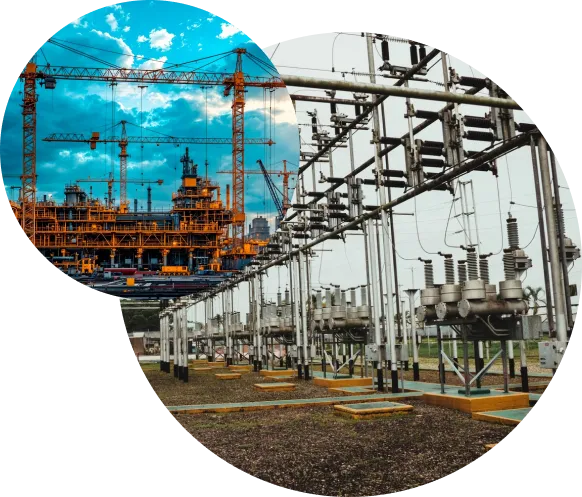
Lighthouse ERP
ERP for Infrastructure & Power Transmission
Simple to Use
Easy to Implement
Flexible to Customized Solution
Executing large-scale infrastructure and power transmission projects is a high-stakes challenge marked by dynamic site operations, regulatory constraints, scattered inventories, and contractor dependencies. With complex Bill of Quantities (BOQs), government audits, and multi-vendor coordination, the industry leaves little room for manual errors or operational blind spots.
In this sector, even minor delays can trigger a chain reaction disrupting site operations, inflating project costs, and damaging stakeholder trust. Whether it’s mobilizing heavy equipment, reconciling contractor bills, or ensuring on-time tower erection in remote terrains, project stakeholders need total control over cost, compliance, and execution.
Lighthouse ERP, with over 38 years of dedicated service in infrastructure and transmission segments, delivers a system built for the ground realities of this sector. The ERP for infrastructure and power is not just a digital ledger but a central nervous system that brings finance teams, project managers, contractors, and field engineers on the same page. Form site-level material management to automated Running Account (RA) billing and project fund tracking. Lighthouse ERP is purpose built to eliminate operational problems and manage the scaling challenges unique to the infrastructure and power transmission industry.

In infrastructure and transmission projects, multiple remote sites operate simultaneously. Lack of centralized control results in miscommunication, delays, and duplicated efforts.
It is frequently difficult to see the transfer of materials from central storage to different project sites without inventory management ERP. This results in overstocking, idle time, or shortages.
Without digital budget controls, field engineers and contractors often exceed sanctioned limits. This causes cost overruns and billing disrupts.
Contractor bills are often raised on spreadsheets or paper. Verifying actual work completed vs. Claimed amount becomes tedious and errors prone.
Without asset tracking ERP expensive assets like transformers, cranes, or tower erection machines have no centralized tracking for movement, maintenance, or depreciation.
Project execution in power transmission involves multiple regulatory approvals and statutory documentation. Delays in compiling these leads to penalties and missed audits.
ERP for the infra and power enables real-time visibility into project progress, cost status and inventory usage across all sites allowing top management to intervene before issues escalate.
With site-level stock tracking and material gate pass validation, Material management ERP module minimizes material misplacement, over issuance, and unrecorded consumption.
ERP directly links contractor bills to work orders, sites log, and progress metrics reducing billing disputes and enabling faster approvals.
Each project, sub-project, and activity is mapped to a defined budget. Alerts are triggered when any item crosses tolerance limits ensuring financial discipline.
ERP software auto-generates statutory documents like RA bills, work completion certificates, TDS, GST reports, and royalty slips, reducing audit failures and compliance risks.
Maintenance schedules based on asset usage data ensure critical machinery like cranes or drilling rigs are serviced on time reducing breakdowns and delays.
Live dashboards track every project’s sanctioned budget, released funds, used resources, and pending liabilities at every stage.
Tracks material issuance, receipts, stock balances, and returns by project site and warehouse ensuring 100% visibility across locations.
Manage work orders, daily progress reports (DPR), billing cycles, retention amounts, and payments all mapped to actual work status.
Automates fund releases per project, tracks fund usage, and generates alerts when expenditure exceeds budget allocation.
Each asset is tagged and tracked across movement, usage hours, maintenance cycles, and depreciation history.
Multi-level approval workflows for PRs, POs, bills, and payment requests with time-stamped logs to maintain transparency.
Centralized digital repository for storing and accessing all licenses, safety certificates, inspection reports, and project documents.
Link procurement requests directly from project BOQs, auto-generate POs, track GRNs, and manage material inward/outward movement at each site.
Centralizes financial transaction management through General Ledger Management, ensuring accurate reporting and compliance. Streamlines accounts payable and receivable processes, provides budgeting and forecasting tools, and facilitates financial reporting for stakeholders. Incorporates cost accounting to track project-related expenses and enhance profitability analysis.
optimizes stock levels and lowers carrying costs by tracking raw materials, work-in-progress, and completed goods in real-time. streamlines purchase orders and vendor selection, among other procurement procedures. Features include warehouse operations management for effective inventory handling and Material Requirement Planning (MRP) for automated material demands based on production schedules.
oversees client orders from receipt to completion, guaranteeing prompt delivery and client satisfaction. incorporates tools for managing quotations and pricing to produce affordable quotes and savings. combines shipping and logistics management for effective product delivery, and it has Customer Relationship Management (CRM) features to increase customer loyalty.
Offers production scheduling and planning solutions to maximize resource use. makes it possible to track output, manpower, and equipment performance in real time while monitoring production operations with Shop Floor Control. uses quality management techniques to guarantee that goods fulfill consumer demands and industry standards.
provides tools for efficient project scheduling and planning, such as timelines and resource allocation. monitors project spending and budgets to make sure it is finished within the allocated funds. enables resource management for the best possible project execution and offers analytics and reporting for accurate decision-making and performance evaluation.